#mexican indigenous folklore
Video
Indigenous Horror Films
#tiktok#indigenous horror films#Indigenous art#Indigenous writers#Indigenous artists#indigenous#watch this#mexican indigenous folklore#folklore#horror#horror films#movies#film#inuit#indie horror film#mythology
13K notes
·
View notes
Text
FOLKLORE POLL
#folklorist#american#american folklore#native american#indigenous#first nations#mexican#mexican folklore#appalachain trail#appalachia#witch#witches#magi#magus#magick
9 notes
·
View notes
Text
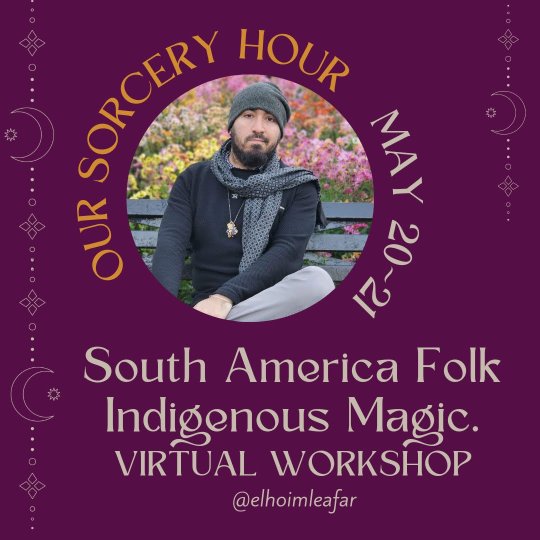
JOIN US ON MAY 20~21. Our Sorcery Hour is Collectively hosted by a group of LGBTQIA members of the craft and made with love for everybody in a safe virtual space for everyone. Recordings are Available immediately after the event for the attendees.
Featuring; Laura Davila (Texas), 'Mexican Sorcery' Author. Mawiyah Bomani (New Orleans), Author of 'Conjuring the Calabash'. Ylva Mara Radziszewski (New Orleans), Author of 'A Practical Guide for Witches' and creator of 'The Living Altar.' Nicholas Pearson (Florida), Author of eight books published by Inner Traditions. Moss Matthey (UK), author of an upcoming book with Llewellyn. Ella Harrison (Latvia), author of 'The Book of Spells'. Aly Kravetz AKA The Bronx Witch (New York), creator of The Bronx Witch Headquarters. Elhoim Leafar (New York), author of 'The Magical Art of Crafting Charm Bags' and the upcoming 'Dream Witchery'.
I'll be here teaching my South America Folk Indigenous Magic class. Which is not just my second most popular class of all time but also the most well-curated, for which I'm constantly researching new information, tales, and folklore.
This virtual-live event includes A Welcoming Ritual, eight workshops of Magic & Witchcraft in two days, and a Meet & Greet with the presenters and host at the end of each day. Recordings of the classes will be available via a private channel on youtube just for the attendees to rewatch and listen to how many times they want for a Year. The whole price of the event is just $40.
Save Your Ticket Here: https://elhoimleafar.com/oursorceryhour/
#santeria#lucumi#candomble#macumba#brujos venezolanos#venezuela#folklore#indigenous bruja#indigenous witch#indigenous magic#native witch#solitary witch#mexican witch#witches of tumblr#venezuelan witch#witches on tumblr#witchcraft
2 notes
·
View notes
Video
Enter a world where dreams become another reality! Dream Rider is a sci fi thriller set in a fictional world inspired by the fascinating cultures of Pre Hispanic Mesoamerica. This suspenseful tale follows a man seeking to unravel a dark conspiracy involving corporate shamans who use the power of dreams and visions to influence reality. Creators Daniel Parada and Louise Fogerty have created a richly imagined, entirely indigenous world inhabited by humans as well as mythical races inspired by Mesoamerican folklore. Their passionate attention to detail is seen in every page of this beautifully illustrated graphic novel. If you love indigenous American culture and history, Dream Rider is for you! Please check out the Kickstarter link to learn more.
https://www.kickstarter.com/projects/zotz/dream-rider-vol-1?ref=thanks-share&fbclid=IwAR0QWO0OP2MxGHVgnyB8RUsX3v8vEcf1uqS3CCU-yZjhMNxQttmGJ-mbY5A
Enjoy this Trailer made in Tik Tok featuring the music “Baile de Nahual” by Nicola Cruz.
#mesoamerica#native american#indigenous#indigenous americans#native mexicans#pre columbian#indigenise#decolonise#artwork#central america#mexico#aztecs#mayans#shamans#shamanism#suspense#graphic novel#dreams#dream seer#folklore#kickstarter
0 notes
Text
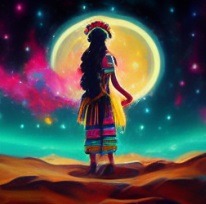

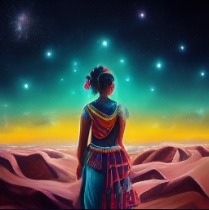


Hecho por midjourney.com
#midjourney#art#ai#artificial intelligence#a.i.#folklore#arte#mexico#maya#stars#moon#amaurylandia#rock#latin#mayan#indigenous#mexican#artificial
1 note
·
View note
Text
Magical girls inspired by the folklore of Indigenous, African, South/South East Asian, Mexican, Brazilian and Aborigine cultures.
33 notes
·
View notes
Text

Life itself 🌵🪶
A piece about reconnecting with my culture
I took inspiration from various indigenous Mexican tribes' traditional peyote art for this one. Peyote has long been used in spiritual and medicinal practices by my tribe, and several tribes in Mexico, for generations.
The sun represents life, the continuation of it, and personal significance for my theriotypes (primarily baboon), which have folklore surrounding the sun in their native territories.
The rebozo being worn is a common design by the Rarámuri. The feathers are cooper's hawk feathers, a bird that holds personal significance for me.
And the necklace being worn is one that I actually own! Made with beads and real coyote claws- it was created by a Cherokee artisan.
#indigenous#native#native american#two spirit#2 spirit#native artist#ntv#my art#more about this piece below the cut#the sig is for my furry handle but thought it would be cool to share on here too :)
10 notes
·
View notes
Text
Deep dives into folklore: Mexican folklore
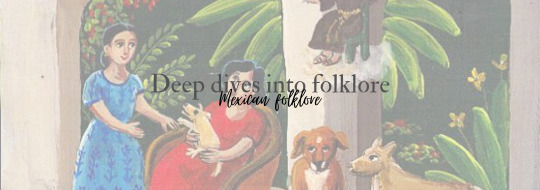
Within the vivid landscapes of Mexico, a captivating mosaic of folklore and mythology unfolds, echoing the voices of ancient civilizations and the whispers of colonial legacies. Mexican folklore, a vibrant narrative quilt, stitches together the threads of indigenous wisdom, Aztec myths, and the syncretic tales born during the Spanish conquest. In this exploration, we embark on a profound journey into the heart of Mexican folklore and mythology, unraveling the tales of gods and goddesses, mythical creatures, and timeless narratives that have woven a rich cultural tapestry throughout the annals of Mexican history.
Mexican folklore finds its roots in the pre-Columbian civilizations that flourished in the region, such as the Aztecs, Maya, and Zapotecs. The syncretism that occurred during the Spanish colonization further enriched the folklore by blending indigenous beliefs with Catholic traditions. This unique fusion gave rise to a diverse pantheon of deities, mythical creatures, and folk heroes, forming the foundation of Mexican folklore.
Aztec Pantheon:
Central to Mexican mythology is the Aztec pantheon, featuring deities like Quetzalcoatl, the feathered serpent, and Tlaloc, the god of rain. Myths surrounding the creation of the world, the struggles between gods, and the cyclical nature of life and death provide a rich backdrop to Mexican folklore.
La Llorona:
One of the most iconic figures in Mexican folklore is La Llorona, the weeping woman. Her haunting tale of love, betrayal, and maternal grief has been passed down through generations, resonating as a cautionary tale and capturing the imagination of storytellers and artists alike.
Nahualli and Nagual:
The concept of the nahual, an animal spirit guide, and its counterpart, the nagual, a human capable of transforming into an animal, reflects the deep connection between humans and the natural world. This belief persists in Mexican folklore, emphasizing the symbiotic relationship between the physical and spiritual realms.
Mexican folklore is not confined to the realm of ancient myths; it remains a living, breathing part of the culture. Festivals, celebrations, and religious rituals often incorporate elements of folklore, providing a link between the past and the present. Day of the Dead (Día de los Muertos) is a prime example, where families honor their ancestors and celebrate the continuity of life through a blend of indigenous and Catholic traditions.
Mexican folklore has profoundly influenced the arts, literature, and visual culture of the nation. Muralists like Diego Rivera and writers like Octavio Paz drew inspiration from the mythic past, infusing their works with the symbolic imagery and narratives of Mexican folklore. Contemporary artists, such as Frida Kahlo, continue to explore and reinterpret these mythic themes, contributing to the ongoing evolution of Mexican cultural identity.
In conclusion, Mexican folklore and mythology are indispensable facets of the nation's cultural identity, reflecting the resilience and creativity of a people shaped by diverse historical influences. From the ancient civilizations to the present day, these myths and tales continue to weave a narrative tapestry that resonates with the soul of Mexico. As the stories of gods, heroes, and spirits endure, they provide a timeless connection to the past and offer a source of inspiration for future generations, ensuring that the echoes of the ancestors will continue to reverberate through the cultural landscape of Mexico.
Taglist (reply or reblog to be added): @axl-ul @crow-flower @thoughts-fromthevoid @alderwoodbooks @harleyacoincidence @tuberosumtater @sonic-spade @theonlygardenia @holymzogynybatman @nulliel-tres @w0rkah0licz @sylvanthorn @tigertaurus22 @profiterole-reads @mathias-musings @1899adgg1997tbmd @grimmparanormalinvestigations
#writeblr#writers of tumblr#writing#bookish#booklr#fantasy books#creative writing#book blog#ya books#ya fantasy books#writers block#teen writer#writblr#tumblr writers#writerblr#writer problems#writers#writers community#writers corner#writers on tumblr#writerscommunity#writerslife#writing blog#writing community#mexican folklore#deep dives into folklore#folklore#myths#mythology
7 notes
·
View notes
Text
best part of that tweet is the new social media folklore that black and indigenous people invented cowboy fashion and culture dkxkskdkslddk. how did “black, native american, and mexican cowboys were a major part of western life” become that
#just kidding i already know because this happens every single time LMFAO#one day we will be able to put people back in the narrative and expand our understanding of culture instead of merely changing#who gets totalitarian ownership of culture
16 notes
·
View notes
Text
tenoch with his production company thoughts:
comedies! dramas! romance! what’s stopping him from telling the stories of indigenous Mexicans? Mexican folklore horror movies?
latino/a/e representation
dark latino/a/e representation
I’m not forgetting other poc and dark-skinned poc rep either
lgbt+ community as a whole rep

latino rep that isn’t every negative stereotype under the sun (poor, gangsters, uneducated, sexist, undocumented, etc)
Latina rep that shows us not as just mothers and partners but as women in top/powerful positions
He wants to do bilingual projects so: bilingual characters who are fluent in both languages (with their accent and all), different race love interests (yes I’m thinking back to Nómadas with Lucy Liu), dark love interests
MUSIC!!! I figure he’s not afraid to give people chances. Younger &/ any race and ethnicities.
SHARE MORE WITH ME IF YOU HAVE SOME PLEASE I LOVE TO HEAR THEM!!!! ❤️
10 notes
·
View notes
Note
I love your recent post about the folklore of the Vanyar! Could you maybe do another one about the Noldor or Teleri in Valinor? Maybe the Teleri have their own version of La Llorona. They probably also have a lot of stories about ghostly shipwrecks and sailors disappearing at sea. Maybe even some stories about sirens. I have no idea about the Noldor though lol. Maybe a cautionary tale about Feanor and the Silmarils?
In response to this post!
I’ll do the Noldor in another post if you want!
I hope this is ok! Let me know if you want more specific examples
The Teleri have a wealth of stories of sea monsters and phenomena include tales from Ossë.
Some of these are at least partly true though many are not.
There are plenty of tales too of more benevolent creatures, some simply real beasts not yet named or recognized, some dream or story, some something else entirely.
For those unaware, La Llorona is a Mexican folktale that speaks of a female specter who cries for the children she herself drowned. Though there is speculation that Aztec stories could have inspired the first iterations of this, the story is actually associated with the relations between Indigenous women in Mexico and the Spanish invaders.
The Teleri of course do not have that specific cultural context however stories of mourning women as specters are a pattern in world mythology and folklore which I actually talked about here in my discussion of the lore of Morwen in Brethil and beyond
I wonder if tales of sea ghosts and drowned children arise after the First Kinslaying especially. Certain ports and lonely stretches of paths along the coasts and surrounding cliffs are rarely frequented and stories are whispered of other residents. This is especially true in families where slain loved ones have not yet returned from Mandos and no word is known of them, a strange missing piece among an immortal people.
As always please feel free to ask more, I love world building and coming up with folklore and stuff.
31 notes
·
View notes
Text
What if Natlan took inspiration from the Aztec death whistles? (GENSHIN RAMBLE)
08.05.2023 | Note by me: Okay guys, I know Fontaine’s 4.0 trailer just came out and it’s far too early to be talking about Natlan that is going to be released in 5.0, BUT I just came across a fact called the “death whistles” from Ancient Mexico and I ran straight here to share with you guys :) So enjoy the read, fellow Natlan enthusiasts! Please note that this is just a ramble about Natlan’s speculation and their soon to be revealed lore, this post is not indicative of Hoyoverse’s final product.
And since I am going to be talking about things heavily related to cultural references, if you are familiar with/apart of the cultures that is being mentioned, please do correct me if I had made a mistake and feel free to add your thoughts in asks or in the tags below! I will add credits to the websites from which I have found this information from in the bottom of this post. Reblogs and credits are very much appreciated. ^^
(CW: Few swear words below the cut!)
So there is this unique part of Aztec culture called the “death whistle” that originated from ancient Mexico. It’s a kind of whistle shaped into a seemingly humanoid carving with an opening to blow into that creates a bone-chilling sound reminiscent of human screams, animal calls, and howling winds. These whistles come in various shapes and produce different variations of sounds. Here are some pictures I found in Google, so this is what they look like:
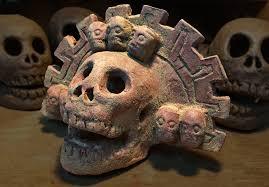

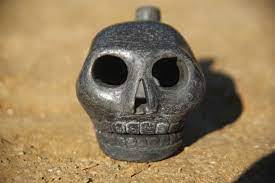

As you may know, Natlan is speculated to be inspired from Pre-Columbian or Indigenous America, alongside influence from Spanish and West African cultures. Either way, it can mean that Natlan may also be inspired from Aztec or early Mexcian cultures and folklore, so it’d make sense that they would add inspiration of the whistles. To list some references of Natlan that we see so far, the nation’s name could be a reference to the language of Nahuatl, meaning “place near where there is abundance [of] Na”. Secondly, the Aztecs worshipped many gods of wars, and Mexico is well-known for its volcanoes, much like Natlan is, and so much more.
Going back, I would conclude that it would be a very interesting and most likely addition if Natlan would include the death whistle which is deeply connected to Aztec and Mexican folklore.
In the immemorial past, these whistles were found in temples that worshipped the wind god Ehecatl (E-he-kah-tl). These whistles were also associated with the Aztec god of death who ruled over the land of the dead from what they call Mictlan, named Mictlāntēcutli (Muhkt-laan-tuh-koot-lee). These instruments were called “whistles of death” because historians believed that they were used to help guide sacrificial victims on their journey to the afterlife. Not only that, but I have also derived information that they were used for religious practices, such as ritual sacrifice, or for something related to battle and war. This fact stood out to me considering Natlan is the Nation of War, and to have these featured in the game’s story would be undoubtedly amazing! And even a good addition to the overall cultural feel and character of Natlan’s dedication to combat. I feel it would enhance the tone of the nation’s lore and even give us a tiny glimpse to the more deeper and darker parts of Genshin lore.
Here is a YouTube link for the sound of the death whistle.
Also, fun fact! Because the whistle is related to the god Ehecatl, the whistles were required to simulate the sounds of the wind because a strong wind cannot be summoned whenever the occasion requires. Interesting isn’t it?
Now, time for my opinions and speculations!
Ever notice how Barbatos and the wind is always vaguely mentioned in the lore of the nations we go through outside of Mondstadt, such as where Barabtos’s seal is strikingly similar to one of the adeptal abodes we visited, or that one letter we found in the Chasm with the Abyss, how Barbatos was vaguely mentioned to be helping Dvorjak to help him in Liyue? Or how the wind god of time, Istaroth, was mentioned in Ei’s Story Quest and the Cecilia flower making appearances in one of the cutscenes in Inazuma? Or maybe you’ve heard of the crazy theories of Irminsul being related to Venti? How about those Anemo vision weilders saving us in each nation we visit? Hahaha, I think I'm going crazy. But.
What if I am not?
Suspiciously enough, from what we’ve learned, these whistles were found in a temple that worships a wind god. You know who else is a god of the wind and has a temple to worship him/her? And the fact that it is also mentioned that a strong wind cannot be summoned in certain occasions, and you know a place in Genshin where the wind does not blow? Yes. Mare Jivari. And surprise, it is also located in Natlan.
I wonder if Venti will be vaguely mentioned once again, but in Natlan. Of all places, he keeps getting mentioned in other nation’s lore. If this is the case, and Venti’s motifs (Wind, song, poetry, cecilias, etc. You get the gist.) OR his god status as Barbatos. If this continues in Fontaine and this happens to be true in Natlan, or even throughout the story in Snezhnaya, then this cannot be a coincidence. After all, we’ve gotten information about Barbatos’s connection with the Tsaritsa, their fallout, and how she is jealous of his power.
Moving on.
I think it would be scary and cool at the same time if we hear that the whistles could even be used in war in Natlan. Perhaps to drive, scare, and even torment their enemies? If Hoyoverse’s writing team would be so bold and even take a step further to amplify Natlan’s culture surrounding war and battle, and even show us as the audience that these people are far more fearsome than they seem, then the death whistle would be such a kickass addition. Who among the people could have discovered it? Their Archon?
Come on, Hoyoverse, don’t be shy. You’ve given us psychological horror from Sumeru’s samsara, Dottore’s experiments, an execution surrounding the God of Eternity’s extra-special technique, now give us some feral fire-bending tribes who could go absolutely apeshit and don’t hesitate to fuck around their enemies like they wanted. Let them do it in honor of war. In honor of the Lady of Fire. Show us that they are tribes that belong to the art of combat. That they are true tribesmen and women that shall serve War at any cost.
Anyway, that is all that I have to share, thank you for reading! And here are the links to the websites from which I got the info!
#genshin impact#natlan#natlan genshin impact#nation of war#genshin ramble#venti#venti genshin impact#barbatos#PHEW this took longer than i expected!#anyway#i'd like to have some people to talk to about#ill be waiting for you guys' thoughts!!!
5 notes
·
View notes
Text
Mexican hummingbird

Mexico, a land rich in cultural diversity and natural beauty, is home to an array of magnificent wildlife. Among its many avian wonders, the Mexican hummingbird stands out as an exquisite and symbolic creature. Beyond its stunning appearance and unique abilities, the Mexican hummingbird carries a deep cultural significance, often associated with the idea of the returning soul.
The marvelous Mexican hummingbird
Mexico is home to over 50 species of hummingbirds, each possessing its distinct characteristics and colors. These tiny birds, often no larger than 3 to 5 inches in length, are renowned for their iridescent plumage, rapid wing flaps, and hovering abilities. Among the notable species found in Mexico are the Violet-crowned Hummingbird, Berylline Hummingbird, and the vibrant Broad-billed Hummingbird.

Violet crowned Hummingbird

Berylline Hummingbird

Broad billed Hummingbird
The Mexican hummingbird's brilliant, jewel-like feathers shimmer in the sunlight, creating a dazzling spectacle in gardens and forests throughout the country. They are often referred to as "jewels of the air," a title that aptly captures their breathtaking beauty.
Symbolism of the returning soul
In Mexican folklore and indigenous cultures, the hummingbird carries profound symbolism, particularly concerning the afterlife and the idea of the returning soul. This symbolism is deeply rooted in the belief that hummingbirds are messengers of the deceased, tasked with carrying the souls of loved ones back to the world of the living.
1. Aztec and Maya beliefs: The ancient Aztecs and Maya civilizations held the hummingbird in high regard. They believed that hummingbirds were sacred creatures associated with the sun god, Huitzilopochtli. These civilizations saw the hummingbird as a symbol of rebirth and resurrection, linking it to the cyclical nature of life and death. The arrival of a hummingbird was seen as a visit from a departed loved one, bringing comfort and a sense of connection to the spiritual realm.
2. Dia de los Muertos: The Mexican Day of the Dead, or Dia de los Muertos, is a deeply rooted tradition where families come together to honor and remember their deceased loved ones. Hummingbirds are often incorporated into the colorful altars and offerings created during this celebration. They are believed to guide the souls of the departed back to their earthly homes, ensuring that they are not forgotten and that their memory lives on.
3. Transformation and resilience: Hummingbirds are known for their resilience and adaptability. In Mexican culture, this trait is associated with the idea that the soul is not bound by death but undergoes a transformation, just as the hummingbird's iridescent plumage appears to change colors as it hovers in the sunlight. This symbolism serves as a reminder of the enduring nature of the human spirit.
4. Love and connection: Hummingbirds are often seen as symbols of love, joy, and connection. The presence of a hummingbird is believed to be a message of love from those who have passed away, fostering a sense of unity and continuity within families.
Further curiosities of Mexican hummingbirds
Aside from their captivating legend in Mayan and Aztec culture, hummingbirds boast an array of fascinating traits and behaviors:
- When at rest, their hearts beat between 500 and 700 times per minute, soaring to an astonishing 1,200 beats per minute during flight.
- They possess the remarkable ability to fly in all directions—right, left, up, down, forward, and backward.
- Hummingbirds flap their wings an astonishing 60 times per second.
- Given their high-energy lifestyle, they must consume nectar equivalent to at least three times their body weight daily.
- Hummingbird sizes range from a mere 2 to 10 inches, depending on the species.
- They are the only birds with elongated, slender beaks, making them exceptional pollinators.
- Their tetrachromatic vision allows them to perceive a broader spectrum of colors than humans.
The Mexican hummingbird's symbolism as a messenger of the returning soul is a testament to the deep spiritual connection that the people of Mexico have with their natural environment. These tiny, vibrant creatures remind us of the beauty of life and the enduring nature of the human spirit. As we marvel at the iridescent colors and graceful movements of Mexican hummingbirds, we can also reflect on the rich cultural tapestry that weaves together the past and the present, celebrating the memory of loved ones and the hope of eternal renewal.
Read the full article
2 notes
·
View notes
Text
Frida Kahlo (1907-1954) Iconic Mexican Painter
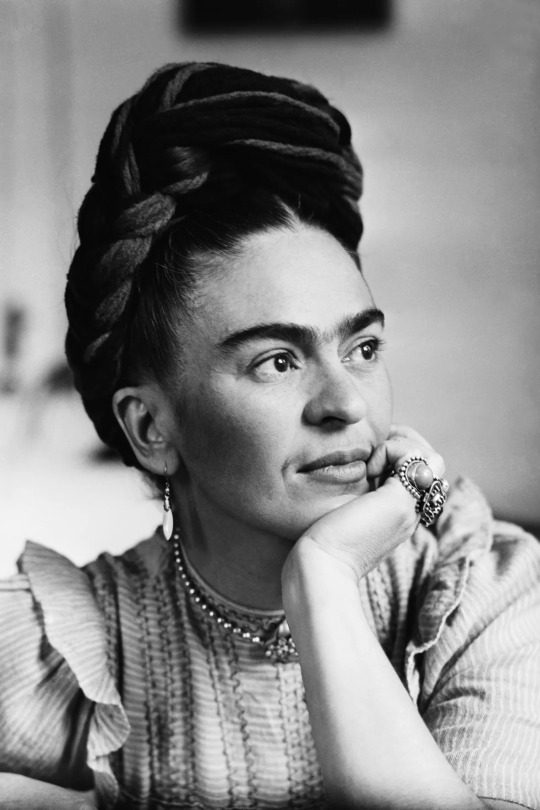
Magdalena Carmen Frida Kahlo y Calderón, known as Frida Kahlo, was born on July 6, 1907, in Coyoacán, a suburb of Mexico City. She grew up in a politically active and artistic family. Kahlo's father, Guillermo Kahlo, was a photographer of German descent, and her mother, Matilde Calderón y González, was of indigenous and Spanish heritage. Frida developed an interest in art from an early age, but her aspirations to become a doctor were thwarted when she experienced a debilitating accident at the age of 18. She was injured in a bus accident that dealt severe injuries throughout her body but the most damaging were to her spine and pelvis. This would forever change her life to be full of surgeries, pain, and recoveries, but sparked her inspiration for her art.
In 1929, Frida Kahlo married the renowned Mexican painter Diego Rivera, who became a significant influence on her artistic development. She first met him at the National Preparatory School in Mexico City. Their marriage was marked by both passion and turbulence. They had a complex relationship characterized by infidelity, separations, and reconciliations; not to mention the two had a 20-year age gap. Rivera is quoted saying Kahlo is “…the most wonderful part of my life" despite cheating on her multiple times. The couple also struggled to conceive children, all of this fueling Frida's complexity in her work, an example is the painting “The Henry Ford Hospital”. Frida's bisexuality and her affairs with both men and women further contributed to the dynamics of their marriage as well. Despite her rough life circumstances, she had a successful art career, she is celebrated for her vibrant and introspective self-portraits, which explored themes of identity, pain, and resilience. Despite enduring chronic physical and emotional pain resulting from her accident and subsequent health issues, Kahlo channeled her experiences into her art. Her paintings often depicted her physical and emotional suffering, along with symbols of Mexican culture, folklore, and politics. Kahlo's unique style combined elements of surrealism, symbolism, and indigenous Mexican art, making her a pioneering figure in the art world. Frida Kahlo's work gained recognition both during her lifetime and posthumously. She had her first solo exhibition in Mexico in 1953, and her art attracted the attention of notable artists such as Pablo Picasso and André Breton. However, it was in the late 1970s and 1980s, long after her death, that Kahlo's art gained widespread international acclaim. Her deeply personal and emotive paintings resonated with audiences, and she became an iconic figure in feminist and LGBTQ+ art movements.

Picture: Self-Portrait with Thorn Necklace and Hummingbird-1940
Frida's art is still prevalent and talked about today, and her legacy is a source of inspiration for multiple groups of people around the world. Kahlo's unapologetic exploration of female identity and her depiction of the female experience have made her an enduring symbol of feminist empowerment. Through her art, she challenged societal norms and patriarchal constraints, providing a voice for women who had long been silenced or marginalized. Her deep connection to her Mexican heritage is evident in her art, which often incorporated Mexican folk art and symbols. She celebrated indigenous culture and the struggles of the Mexican people, helping to promote Mexican identity and pride both within Mexico and internationally. Frida's artistic style and thematic exploration have inspired countless contemporary artists. Her powerful portrayal of pain, identity, and the human experience continues to resonate with artists and audiences worldwide. Kahlo's influence can be seen in various forms of visual art, as well as in fashion, music, and popular culture.
Frida Kahlo's legacy extends beyond her own artwork. Her life story, resilience, and ability to find beauty in the face of adversity have inspired generations. She remains an enduring symbol of strength, creativity, and self-expression, encouraging individuals to embrace their authentic selves and embrace the transformative power of art. As an artist and cultural icon goes far beyond her extraordinary paintings… encompassing boldness, resilience, and commitment to self-expression have left an indelible mark on the art world, inspiring generations of artists and serving as a beacon of empowerment for marginalized communities.
Interested in viewing her work?:
For more information on Frida Kahlo:
Time log: 00:54:48
3 notes
·
View notes
Note
I’m not sure if La Llorona belongs on that list because even if that legend is derived from older myths, it’s derived by Mexican people. It’s not white people, which your post implied. La Llorona is still important to Hispanic culture even if there’s older versions of her, and she isn’t a “white people thing.”
I included her because I've seen her included by White people when talking about "cryptids", the implication here is that white people inaccurately call these spirits "cryptids" because of the weird fascination with them. I was generally aware of La Llorona's importance as Mexican Folklore, and I also included her to ASSERT her importance (same as the others on the list) because of how people will sometimes reduce her to "just a cryptid". If I'm saying La Llorona is a "white people thing" wouldn't that go for the rest of the list, which is obviously wrong? These spirits aren't a "white people thing" at all because they have their origins in people who aren't white? She's included because just saying she's a "cryptid" like some people do would be reducing her importance & still appropriative of Mexican folklore & very likely, appropriative of extension Indigenous Mexican legends
#I don't think cryptids are a 'white people thing' I'm specifically talking about specific White people who are obsessed with Native spirits#& reduce them down to 'cryptids'
20 notes
·
View notes
Text

JOIN US ON MAY 20~21. Our Sorcery Hour is Collectively hosted by a group of LGBTQIA members of the craft and made with love for everybody in a safe virtual space for everyone. Recordings are Available immediately after the event for the attendees.
Featuring; Laura Davila (Texas), 'Mexican Sorcery' Author. Mawiyah Bomani (New Orleans), Author of 'Conjuring the Calabash'. Ylva Mara Radziszewski (New Orleans), Author of 'A Practical Guide for Witches' and creator of 'The Living Altar.' Nicholas Pearson (Florida), Author of eight books published by Inner Traditions. Moss Matthey (UK), author of an upcoming book with Llewellyn. Ella Harrison (Latvia), author of 'The Book of Spells'. Aly Kravetz AKA The Bronx Witch (New York), creator of The Bronx Witch Headquarters. Elhoim Leafar (New York), author of 'The Magical Art of Crafting Charm Bags' and the upcoming 'Dream Witchery'.
I'll be here teaching my South America Folk Indigenous Magic class. Which is not just my second most popular class of all time but also the most well-curated, for which I'm constantly researching new information, tales, and folklore.
This virtual-live event includes A Welcoming Ritual, eight workshops of Magic & Witchcraft in two days, and a Meet & Greet with the presenters and host at the end of each day. Recordings of the classes will be available via a private channel on youtube just for the attendees to rewatch and listen to how many times they want for a Year. The whole price of the event is just $40.
Save Your Ticket Here: https://elhoimleafar.com/oursorceryhour/
#solitary witch#mexican witch#witches of tumblr#witches on tumblr#witchcraft#witches#witchblr#sorcery#magick#hoodoo#voodoo#black witch#calabash#lucumi#brujos of tumblr#brujas#black witches
4 notes
·
View notes